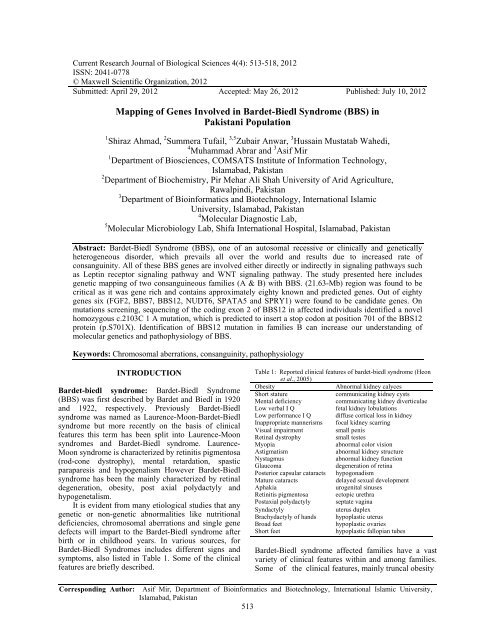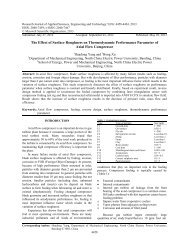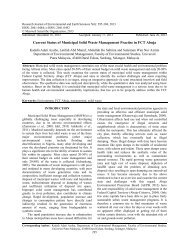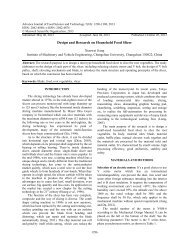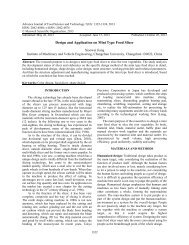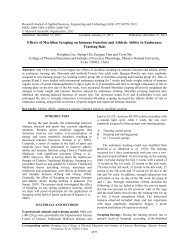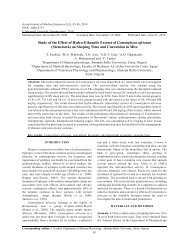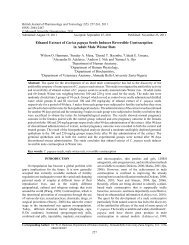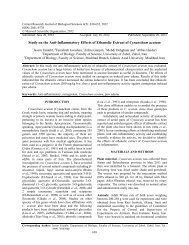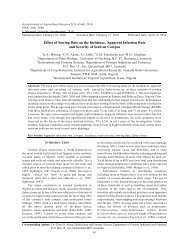Mapping of Genes Involved in Bardet-Biedl ... - Maxwell Science
Mapping of Genes Involved in Bardet-Biedl ... - Maxwell Science
Mapping of Genes Involved in Bardet-Biedl ... - Maxwell Science
You also want an ePaper? Increase the reach of your titles
YUMPU automatically turns print PDFs into web optimized ePapers that Google loves.
Current Research Journal <strong>of</strong> Biological <strong>Science</strong>s 4(4): 513-518, 2012<br />
ISSN: 2041-0778<br />
© <strong>Maxwell</strong> Scientific Organization, 2012<br />
Submitted: April 29, 2012 Accepted: May 26, 2012 Published: July 10, 2012<br />
<strong>Mapp<strong>in</strong>g</strong> <strong>of</strong> <strong>Genes</strong> <strong>Involved</strong> <strong>in</strong> <strong>Bardet</strong>-<strong>Biedl</strong> Syndrome (BBS) <strong>in</strong><br />
Pakistani Population<br />
1 Shiraz Ahmad, 2 Summera Tufail, 3,5 Zubair Anwar, 3 Hussa<strong>in</strong> Mustatab Wahedi,<br />
4 Muhammad Abrar and 3 Asif Mir<br />
1 Department <strong>of</strong> Biosciences, COMSATS Institute <strong>of</strong> Information Technology,<br />
Islamabad, Pakistan<br />
2 Department <strong>of</strong> Biochemistry, Pir Mehar Ali Shah University <strong>of</strong> Arid Agriculture,<br />
Rawalp<strong>in</strong>di, Pakistan<br />
3 Department <strong>of</strong> Bio<strong>in</strong>formatics and Biotechnology, International Islamic<br />
University, Islamabad, Pakistan<br />
4 Molecular Diagnostic Lab,<br />
5 Molecular Microbiology Lab, Shifa International Hospital, Islamabad, Pakistan<br />
Abstract: <strong>Bardet</strong>-<strong>Biedl</strong> Syndrome (BBS), one <strong>of</strong> an autosomal recessive or cl<strong>in</strong>ically and genetically<br />
heterogeneous disorder, which prevails all over the world and results due to <strong>in</strong>creased rate <strong>of</strong><br />
consangu<strong>in</strong>ity. All <strong>of</strong> these BBS genes are <strong>in</strong>volved either directly or <strong>in</strong>directly <strong>in</strong> signal<strong>in</strong>g pathways such<br />
as Lept<strong>in</strong> receptor signal<strong>in</strong>g pathway and WNT signal<strong>in</strong>g pathway. The study presented here <strong>in</strong>cludes<br />
genetic mapp<strong>in</strong>g <strong>of</strong> two consangu<strong>in</strong>eous families (A & B) with BBS. (21.63-Mb) region was found to be<br />
critical as it was gene rich and conta<strong>in</strong>s approximately eighty known and predicted genes. Out <strong>of</strong> eighty<br />
genes six (FGF2, BBS7, BBS12, NUDT6, SPATA5 and SPRY1) were found to be candidate genes. On<br />
mutations screen<strong>in</strong>g, sequenc<strong>in</strong>g <strong>of</strong> the cod<strong>in</strong>g exon 2 <strong>of</strong> BBS12 <strong>in</strong> affected <strong>in</strong>dividuals identified a novel<br />
homozygous c.2103C 1 A mutation, which is predicted to <strong>in</strong>sert a stop codon at position 701 <strong>of</strong> the BBS12<br />
prote<strong>in</strong> (p.S701X). Identification <strong>of</strong> BBS12 mutation <strong>in</strong> families B can <strong>in</strong>crease our understand<strong>in</strong>g <strong>of</strong><br />
molecular genetics and pathophysiology <strong>of</strong> BBS.<br />
Keywords: Chromosomal aberrations, consangu<strong>in</strong>ity, pathophysiology<br />
INTRODUCTION<br />
<strong>Bardet</strong>-biedl syndrome: <strong>Bardet</strong>-<strong>Biedl</strong> Syndrome<br />
(BBS) was first described by <strong>Bardet</strong> and <strong>Biedl</strong> <strong>in</strong> 1920<br />
and 1922, respectively. Previously <strong>Bardet</strong>-<strong>Biedl</strong><br />
syndrome was named as Laurence-Moon-<strong>Bardet</strong>-<strong>Biedl</strong><br />
syndrome but more recently on the basis <strong>of</strong> cl<strong>in</strong>ical<br />
features this term has been split <strong>in</strong>to Laurence-Moon<br />
syndromes and <strong>Bardet</strong>-<strong>Biedl</strong> syndrome. Laurence-<br />
Moon syndrome is characterized by ret<strong>in</strong>itis pigmentosa<br />
(rod-cone dystrophy), mental retardation, spastic<br />
paraparesis and hypogenalism However <strong>Bardet</strong>-<strong>Biedl</strong><br />
syndrome has been the ma<strong>in</strong>ly characterized by ret<strong>in</strong>al<br />
degeneration, obesity, post axial polydactyly and<br />
hypogenetalism.<br />
It is evident from many etiological studies that any<br />
genetic or non-genetic abnormalities like nutritional<br />
deficiencies, chromosomal aberrations and s<strong>in</strong>gle gene<br />
defects will impart to the <strong>Bardet</strong>-<strong>Biedl</strong> syndrome after<br />
birth or <strong>in</strong> childhood years. In various sources, for<br />
<strong>Bardet</strong>-<strong>Biedl</strong> Syndromes <strong>in</strong>cludes different signs and<br />
symptoms, also listed <strong>in</strong> Table 1. Some <strong>of</strong> the cl<strong>in</strong>ical<br />
features are briefly described.<br />
Table 1: Reported cl<strong>in</strong>ical features <strong>of</strong> bardet-biedl syndrome (Heon<br />
et al., 2005)<br />
Obesity Abnormal kidney calyces<br />
Short stature communicat<strong>in</strong>g kidney cysts<br />
Mental deficiency communicat<strong>in</strong>g kidney diverticulae<br />
Low verbal I Q fetal kidney lobulations<br />
Low performance I Q diffuse cortical loss <strong>in</strong> kidney<br />
Inappropriate mannerisms focal kidney scarr<strong>in</strong>g<br />
Visual impairment small penis<br />
Ret<strong>in</strong>al dystrophy small testes<br />
Myopia abnormal color vision<br />
Astigmatism abnormal kidney structure<br />
Nystagmus abnormal kidney function<br />
Glaucoma degeneration <strong>of</strong> ret<strong>in</strong>a<br />
Posterior capsular cataracts hypogonadism<br />
Mature cataracts delayed sexual development<br />
Aphakia urogenital s<strong>in</strong>uses<br />
Ret<strong>in</strong>itis pigmentosa ectopic urethra<br />
Postaxial polydactyly septate vag<strong>in</strong>a<br />
Syndactyly uterus duplex<br />
Brachydactyly <strong>of</strong> hands hypoplastic uterus<br />
Broad feet hypoplastic ovaries<br />
Short feet hypoplastic fallopian tubes<br />
<strong>Bardet</strong>-<strong>Biedl</strong> syndrome affected families have a vast<br />
variety <strong>of</strong> cl<strong>in</strong>ical features with<strong>in</strong> and among families.<br />
Some <strong>of</strong> the cl<strong>in</strong>ical features, ma<strong>in</strong>ly truncal obesity<br />
Correspond<strong>in</strong>g Author: Asif Mir, Department <strong>of</strong> Bio<strong>in</strong>formatics and Biotechnology, International Islamic University,<br />
Islamabad, Pakistan<br />
513
Curr. Res. J. Biol. Sci., 4(4): 513-518, 2012<br />
Fig. 1: Reported BBS genes percentage <strong>in</strong> general population (Blacque et al., 2004)<br />
which is problematic throughout adulthood, learn<strong>in</strong>g Islamabad, Pakistan. Two families A and B were<br />
problems; post taxial polydactyly, cone-rod collected, one from Azad Kashmir and another from<br />
dystrophy, child age vision loss which leads to night<br />
bl<strong>in</strong>dness, micropenis, renal dysfunction and complex<br />
female genital malformation are the causes <strong>of</strong> BBS.<br />
Throughout the world, BBS is prevailed with<br />
differential frequency rate because <strong>of</strong> a systemic<br />
disorder. Number <strong>of</strong> affected person <strong>of</strong> this syndrome is<br />
1 <strong>in</strong> 150,000 <strong>in</strong>dividuals accord<strong>in</strong>g to estimation.<br />
Geographic isolated races or high consangu<strong>in</strong>ity<br />
populations have high rate <strong>of</strong> <strong>in</strong>cidence. In Kuwait and<br />
new founded lands rate <strong>of</strong> BBS is 1: 13,500 and 1:<br />
7,500 as compare to Europe and North America (1:<br />
140,000 to 1: 160,000), respectively (Nicholas et al.,<br />
2001). Due to high consangu<strong>in</strong>ity <strong>in</strong> the population <strong>of</strong><br />
Bedou<strong>in</strong> and Arab tribes, rate <strong>of</strong> BBS is also high.<br />
Reported BBS genes percentages <strong>in</strong> general population<br />
are mentioned <strong>in</strong> Fig. 1.<br />
In our population, it is still question marked that<br />
why this <strong>in</strong>cidence happened? Complete survey <strong>of</strong><br />
affected families is required <strong>in</strong> Pakistan. Increase <strong>in</strong><br />
<strong>in</strong>cidence can effect on overall socioeconomic setup <strong>of</strong><br />
development <strong>of</strong> Pakistan but it can be handled by the<br />
help <strong>of</strong> genetic counsel<strong>in</strong>g to reduce this syndrome. By<br />
our this study we can explore the genetics <strong>of</strong> BBS more<br />
keenly, which will be fruitfull for our com<strong>in</strong>g<br />
generations. This will also affect positively to our<br />
country and an add up for the whole world, however a<br />
little bit but it will be fruitfull.<br />
Khyber Pakhtoon Khwa, for the current study. Family<br />
A and family B, both were <strong>in</strong>dicat<strong>in</strong>g <strong>Bardet</strong>-<strong>Biedl</strong><br />
Syndrome (BBS) disorder. Informed consents were<br />
obta<strong>in</strong>ed from all the family members who participated<br />
<strong>in</strong> the study. Both the families were visited at their<br />
places <strong>of</strong> residence to generate the pedigrees and collect<br />
the relevant <strong>in</strong>formation. The <strong>in</strong>formation obta<strong>in</strong>ed was<br />
crosschecked by <strong>in</strong>terview<strong>in</strong>g different family<br />
members.<br />
The cl<strong>in</strong>ical exam<strong>in</strong>ation was performed at the<br />
local hospital for both the families. All affected<br />
members <strong>of</strong> both the families were cl<strong>in</strong>ically exam<strong>in</strong>ed<br />
<strong>in</strong>clud<strong>in</strong>g general physical exam<strong>in</strong>ation,<br />
ophthalmological exam<strong>in</strong>ation, X-rays <strong>of</strong> hands and<br />
feet and abdom<strong>in</strong>al ultrasound. Patients <strong>of</strong> family B<br />
were referred to the hospital due to bilateral polydactyly<br />
and mild vision impairment.<br />
After a thorough discussion with elders <strong>of</strong> these<br />
families, genetic pedigrees were drawn accord<strong>in</strong>g to<br />
standard method. The mode <strong>of</strong> <strong>in</strong>heritance <strong>of</strong> disorder<br />
was <strong>in</strong>ferred by observ<strong>in</strong>g segregation <strong>of</strong> disease with<strong>in</strong><br />
family. Pedigree was constructed for each family by<br />
standard method described by Bennett et al. (1995). In<br />
the pedigree, males are symbolized by squares and<br />
females by circles. Filled circles and squares represent<br />
affected <strong>in</strong>dividuals, while normal <strong>in</strong>dividuals are<br />
represented with unfilled symbols. Deceased<br />
MATERIALS AND METHODS<br />
<strong>in</strong>dividuals are represented by a slant<strong>in</strong>g l<strong>in</strong>e on the<br />
square or circle. Double l<strong>in</strong>es <strong>in</strong> the pedigrees represent<br />
This study was done <strong>in</strong> year 2009 to 2010 and all consangu<strong>in</strong>eous marriages.<br />
the wet lab process<strong>in</strong>g was done <strong>in</strong> HMG lab, The blood samples from both normal and affected<br />
COMSATS <strong>in</strong>stitute <strong>of</strong> <strong>in</strong>formation technology, <strong>in</strong>dividuals <strong>in</strong>clud<strong>in</strong>g their parents were collected by 10<br />
514
mL clean and sterilized syr<strong>in</strong>ges (0.7×40 mm 0.22<br />
×1½) (BD, USA) and from children below 2 years <strong>of</strong><br />
age by butterflies, <strong>in</strong> standard potassium EDTA<br />
vacuta<strong>in</strong>er tubes (BD, USA). The blood samples,<br />
collected <strong>in</strong> the field, were stored at 4°C <strong>in</strong> the<br />
laboratory, before be<strong>in</strong>g processed for extraction <strong>of</strong><br />
genomic DNA.<br />
Genomic DNA was purified from blood collected<br />
<strong>in</strong> EDTA tubes accord<strong>in</strong>g to already established Phenol<br />
extraction method (Organic Method) and then agarose<br />
gel electrophoresis was done.<br />
Genotyp<strong>in</strong>g was done by us<strong>in</strong>g standard method (as<br />
follows) us<strong>in</strong>g micro-satellite markers Micro-satellite<br />
markers were from the Marshfield maps and were<br />
obta<strong>in</strong>ed from Research. Genetics Inc. (USA). The<br />
cytogenetic locations <strong>of</strong> these markers, their<br />
heterozygosity as well as length <strong>of</strong> the amplified<br />
products were obta<strong>in</strong>ed from Genome Database<br />
homepage, Marshfield Medical Center and Rutger’s<br />
Map. After that Polymerase Cha<strong>in</strong> Reaction was<br />
performed by the use <strong>of</strong> thermal cyclers provided by<br />
Perk<strong>in</strong> Elmer (Veriti system, Applied Biosystems,<br />
USA).<br />
For allele separation amplified PCR products were<br />
resolved on 8% non-denatur<strong>in</strong>g poly-acrylamide gel.<br />
The gel was sta<strong>in</strong>ed with ethidium bromide (100<br />
mg/mL) solution and visualized on UV<br />
transillum<strong>in</strong>ator. The alleles <strong>of</strong> the micro satellite<br />
markers were visualized by plac<strong>in</strong>g the ethidium<br />
bromide sta<strong>in</strong>ed gel on UV transillum<strong>in</strong>ator and<br />
documented with Gel, DOC-XR Gel Documentation<br />
system (Bio-Rad, UK) and analyzed with Quantity one<br />
(Bio-Rad, UK) s<strong>of</strong>t ware package.<br />
Genetic databases were screened to select which<br />
genes and loci are already known to associate with<br />
<strong>Bardet</strong>-<strong>Biedl</strong> Syndrome (BBS) <strong>in</strong> Pakistani Population.<br />
Based on the results <strong>of</strong> these searches, both the families<br />
(A and B) were screened <strong>in</strong>itially for l<strong>in</strong>kage to known<br />
loci. Genotyp<strong>in</strong>g was carried out <strong>in</strong> families A and B<br />
with microsatellite markers associated with BBS loci.<br />
Selected markers had an average heterozygosity <strong>of</strong><br />
>70%. After scor<strong>in</strong>g the alleles for each marker, the<br />
segregation pattern <strong>of</strong> alleles <strong>of</strong> both normal and<br />
affected <strong>in</strong>dividuals was analyzed. To screen mutation<br />
<strong>in</strong> the BBS12 locus, the genes tested were FGF2, BBS7,<br />
BBS12, NUDT6, SPATA5 and SPRY. These genes<br />
were PCR amplified from genomic DNA.<br />
The purified PCR products were subjected to cycle<br />
sequenc<strong>in</strong>g us<strong>in</strong>g big dye term<strong>in</strong>ator V 3.1 ready<br />
reaction mix and sequenc<strong>in</strong>g buffer (PE Applied<br />
Biosystems, Foster City, CA, USA). The sequenc<strong>in</strong>g<br />
products were purified to remove un<strong>in</strong>corporated<br />
Curr. Res. J. Biol. Sci., 4(4): 513-518, 2012<br />
515<br />
nucleotide and primers with Centriflex TM Gel<br />
Filtration Cartridge (DGE Biosystems, Gaithersburg,<br />
MD, USA). These purified products were re-suspended<br />
<strong>in</strong> 10 uL <strong>of</strong> TSR (Template Suppression Reagent) and<br />
were placed <strong>in</strong> 0.5 mL septa tubes to be directly<br />
sequenced <strong>in</strong> an ABI Prism 310 Automated Sequencer<br />
(PE Applied Biosystems, Foster City, CA, USA).<br />
Chromatograms from normal and affected <strong>in</strong>dividuals<br />
were compared with the correspond<strong>in</strong>g control gene<br />
sequences from NCBI (National Center <strong>of</strong><br />
Biotechnology Information) database to identify the<br />
aberrant nucleotide base-pair change.<br />
RESULTS AND DISCUSSION<br />
<strong>Bardet</strong>-<strong>Biedl</strong> Syndrome is an autosomal recessive<br />
disorder prevail<strong>in</strong>g all over the world and it results due<br />
to consangu<strong>in</strong>ity that is the characteristics from the<br />
same l<strong>in</strong>eage like another person hav<strong>in</strong>g the same<br />
ancestor. So there are always greater chances <strong>of</strong> the<br />
occurrence <strong>of</strong> genetic disorder <strong>in</strong> the <strong>of</strong>fspr<strong>in</strong>g hav<strong>in</strong>g<br />
this k<strong>in</strong>d <strong>of</strong> relationships. The most common features<br />
which are always under consideration dur<strong>in</strong>g the<br />
diagnosis <strong>of</strong> BBS are congenital postaxial polydactyly<br />
<strong>in</strong>clud<strong>in</strong>g syndactyly and brachydactyly present <strong>in</strong><br />
approximately 70% <strong>of</strong> cases and Ret<strong>in</strong>itis Pigmentosa<br />
(RP) is found to occur <strong>in</strong> the early child hood.<br />
Moreover there are common renal abnormalities dur<strong>in</strong>g<br />
the course <strong>of</strong> development. There is autosomal<br />
recessive disorder <strong>in</strong> the <strong>in</strong>dividual which are<br />
homozygous for specific gene mutation. It means that<br />
the <strong>in</strong>dividuals are carrier <strong>of</strong> gene with two similar<br />
alleles. But <strong>in</strong> few cases due to novel mutation, the<br />
parents <strong>of</strong> affected <strong>in</strong>dividual must be carrier <strong>of</strong> gene.<br />
Such parents are completely unaware <strong>of</strong> the truth that<br />
they are the carrier <strong>of</strong> defected gene as they don’t show<br />
any signs and symptoms <strong>of</strong> be<strong>in</strong>g carrier. We can say<br />
that the more is the degree <strong>of</strong> genetic correlation<br />
between the parents; more will be the risk <strong>of</strong> disease.<br />
But the risk is lower <strong>in</strong> the <strong>in</strong>dividual which have<br />
distant relationship like second cous<strong>in</strong>. It is obvious that<br />
there is large variability <strong>in</strong> the cl<strong>in</strong>ical and phenotypic<br />
features <strong>of</strong> <strong>Bardet</strong> <strong>Biedl</strong> syndrome.<br />
By us<strong>in</strong>g homozygosity mapp<strong>in</strong>g criteria, the<br />
recessive trait can be mapped through the <strong>of</strong>fspr<strong>in</strong>g <strong>of</strong><br />
the consangu<strong>in</strong>eous mat<strong>in</strong>g. Because <strong>of</strong> genetic nature<br />
<strong>of</strong> the recessive <strong>in</strong>heritance, regions <strong>in</strong> close proximity<br />
<strong>of</strong> the disease caus<strong>in</strong>g locus are likely to be<br />
homozygous by descent <strong>in</strong> patients from the<br />
consangu<strong>in</strong>eous families (Lander and Boste<strong>in</strong>, 1987;<br />
Sheffield et al., 1998). The homozygosity mapp<strong>in</strong>g is a
Curr. Res. J. Biol. Sci., 4(4): 513-518, 2012<br />
I:1 I:2<br />
II:3 II:1 II:2<br />
II:4<br />
III:1 III:2 III:3<br />
IV:1 IV:2 IV:3 IV:4 IV:5 IV:6 IV:7 IV:8 IV:9<br />
Fig. 2: Pedigree <strong>of</strong> family A with BBS. Circles represent females and squares show males. Filled squares and circles represent<br />
affected <strong>in</strong>dividuals, whereas double l<strong>in</strong>es <strong>in</strong>dicate consangu<strong>in</strong>eous marriage<br />
I:1 I:2<br />
II:1 II:2 II:3<br />
II:4<br />
IV:1<br />
Blood<br />
III:1<br />
IV:2<br />
Blood<br />
IV:3<br />
Blood<br />
IV:4<br />
Blood<br />
516<br />
III:2<br />
IV:5<br />
Blood<br />
Blood<br />
Blood<br />
IV:6 IV:7<br />
Fig. 3: Pedigree <strong>of</strong> family B with BBS. Circles represent females and squares show males. Filled squares and circles represent<br />
affected <strong>in</strong>dividuals, whereas double l<strong>in</strong>es <strong>in</strong>dicate consangu<strong>in</strong>eous marriage<br />
suitable method for fish<strong>in</strong>g out disease caus<strong>in</strong>g gene <strong>in</strong><br />
this disease. In order to establish a l<strong>in</strong>kage, at least four<br />
affected sibl<strong>in</strong>g are required <strong>in</strong> first cous<strong>in</strong> marriage and<br />
only three affected sibl<strong>in</strong>gs are required <strong>in</strong> the second<br />
cous<strong>in</strong> marriage.<br />
In family A mentioned <strong>in</strong> Fig. 2 six DNA samples<br />
(III: 2, IV: 1, IV: 2 IV: 3, IV: 4, IV: 6) <strong>in</strong>clud<strong>in</strong>g two<br />
normal and four affected <strong>in</strong>dividuals were selected for<br />
genotyp<strong>in</strong>g the markers l<strong>in</strong>ked to the candidate genes.<br />
In family B mentioned <strong>in</strong> Fig. 3, ten DNA samples,<br />
three BBS affected (IV: 2, IV: 3, IV: 9) four mentally<br />
retarded (IV: 1, IV: 5, IV: 6, IV: 8) and normal (III: 2,<br />
III: 3, IV: 4) were selected for genotyp<strong>in</strong>g the markers<br />
<strong>in</strong> the vic<strong>in</strong>ity <strong>of</strong> known loci. Cl<strong>in</strong>ically, the affected
Fig. 4: Schematic view <strong>of</strong> genome wide LOD score<br />
calculations for family B. The arrows <strong>in</strong>dicate<br />
regions <strong>of</strong> maximum LOD scores <strong>of</strong> 1.83<br />
(a)<br />
(b)<br />
Fig. 5: Sequence chromatograms <strong>of</strong> c.2103C 1 A mutation <strong>in</strong><br />
the <strong>in</strong>dex patient (IV-3), heterozygous carrier (III-2),<br />
and a healthy control <strong>of</strong> family B<br />
(c)<br />
Curr. Res. J. Biol. Sci., 4(4): 513-518, 2012<br />
517<br />
<strong>in</strong>dividuals showed polydactyly <strong>of</strong> hands and feet.<br />
These affected <strong>in</strong>dividuals also showed progressive<br />
night bl<strong>in</strong>dness which was mild <strong>in</strong> day time. It has been<br />
diagnosed through ophthalmological studies which<br />
have been carried out <strong>in</strong> Shifa Eye Trust Hospital <strong>in</strong><br />
Rawalp<strong>in</strong>di that all the affected <strong>in</strong>dividuals have<br />
atypical Ret<strong>in</strong>itis Pigmentosa (RP), myopia and<br />
astigmatism. However obesity and no renal<br />
abnormalities were observed <strong>in</strong> affected <strong>in</strong>dividuals.<br />
But physical exam<strong>in</strong>ation showed hypodontia <strong>in</strong> all the<br />
affected <strong>in</strong>dividuals. Analysis <strong>of</strong> the results showed the<br />
l<strong>in</strong>kage for BBS12 locus on 4q27 and identification <strong>of</strong> a<br />
novel BBS12 mutation. Genome-wide LOD score<br />
calculations resulted <strong>in</strong> maximum LOD scores <strong>of</strong> 1.83<br />
mentioned <strong>in</strong> Fig. 4 at chromosomal region located on<br />
chromosome 4q27-4q31.22, respectively. In family B,<br />
21.63-Mb region was found to be critical as it was gene<br />
rich and conta<strong>in</strong>s approximately eighty known and<br />
predicted genes. Out <strong>of</strong> eighty genes six (FGF2, BBS7,<br />
BBS12, NUDT6, SPATA5 and SPRY1) were found to<br />
be candidate genes. Mutation analysis <strong>of</strong> affected<br />
<strong>in</strong>dividuals resulted <strong>in</strong> the identification <strong>of</strong> novel<br />
mutation i.e., p.S701X. On mutations screen<strong>in</strong>g,<br />
sequenc<strong>in</strong>g <strong>of</strong> the cod<strong>in</strong>g exon 2 <strong>of</strong> BBS12 <strong>in</strong> affected<br />
<strong>in</strong>dividuals identified a novel homozygous c.2103C 1 A<br />
mutation ment<strong>in</strong>ed <strong>in</strong> Fig. 5, which is predicted to <strong>in</strong>sert<br />
a stop codon at position 701 <strong>of</strong> the BBS12 prote<strong>in</strong><br />
(p.S701X).<br />
CONCLUSION<br />
From the analysis <strong>of</strong> the results obta<strong>in</strong>ed with<br />
polymorphic micro-satellite markers specific for known<br />
BBS loci, it was evident that all the affected and normal<br />
<strong>in</strong>dividuals were homozygous for the different<br />
comb<strong>in</strong>ations. In family A, the l<strong>in</strong>kage was established<br />
to BBS8 locus. Hence Identification <strong>of</strong> BBS12 mutation<br />
<strong>in</strong> family B can <strong>in</strong>crease our understand<strong>in</strong>g <strong>of</strong><br />
molecular genetics and pathophysiology <strong>of</strong> BBS. By<br />
this cont<strong>in</strong>uous screen<strong>in</strong>g <strong>of</strong> more population we can go<br />
more deep <strong>in</strong> the root cause mutations and genes ly<strong>in</strong>g<br />
beneath this disorder to explore it more.<br />
REFERENCES<br />
Bennett, R.L., K.A. Ste<strong>in</strong>haus, S.B. Uhrich, C.K.<br />
O'Sullivan, R.G. Resta, D. Lochner-Doyle, D.S.<br />
Markel, V. V<strong>in</strong>cent and J. Hamanishi, 1995.<br />
Recommendations for standardized human<br />
pedigree nomenclature. Am. J. Hum. Genet., 56:<br />
745-752.
Blacque, O.E., M.J. Reardon, C. Li, J. McCarthy,<br />
M.R. Mahjoub, S.J. Ansley, et al., 2004. Loss <strong>of</strong> C.<br />
elegans BBS-7 and BBS-8 prote<strong>in</strong> function results<br />
<strong>in</strong> cilia defects and compromised <strong>in</strong>traflagellar<br />
transport. <strong>Genes</strong> Dev., 18: 1630-1642.<br />
Heon, E., C. Westall, R. Carmi, K. Elbedour, C. Panton,<br />
L. Mackeen, E.M. Stone and V.C. Sheffield, 2005.<br />
Ocular phenotypes <strong>of</strong> three genetic variants <strong>of</strong><br />
<strong>Bardet</strong>-<strong>Biedl</strong> syndrome. Am. J. Med. Genet. A,<br />
132: 283-287.<br />
Curr. Res. J. Biol. Sci., 4(4): 513-518, 2012<br />
518<br />
Lander, E.S. and D. Botste<strong>in</strong>, 1987. Homozygosity<br />
mapp<strong>in</strong>g: A way to map human recessive traits<br />
with the DNA <strong>of</strong> <strong>in</strong>bred children. <strong>Science</strong>, 236:<br />
1567-1570, DOI: 10.1126/science.2884728.<br />
Nicholas, K., J.R., Lupski and P.L. Beales, 2001.<br />
Explor<strong>in</strong>g the Molecular basis <strong>of</strong> <strong>Bardet</strong>-<strong>Biedl</strong><br />
syndrome. Hum. Mol. Genet., 20: 2293-2299.<br />
Sheffield, V.S., E.M. Stone and R. Carmi, 1998. Use <strong>of</strong><br />
isolated <strong>in</strong>bred human populations for<br />
identification <strong>of</strong> disease genes. Trends Genet., 14:<br />
391-396.


